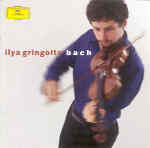Ilya Gringolts cuts a broad swath through these Bach stalwarts to the point that his bow becomes something of a scythe. He attacks the myriad triple-stops, particularly in the Tempo di Bouree of the first Partita and in the Fugue of the second Sonata, with biting intensity. His tempo choices are invariably on the swift side and often are executed with restless aggression combined with spot-on accuracy. Heightened both by his preternaturally large rounded tone and close-up recorded sound, the after-effect of such a recital may result in a certain amount of exhaustion for the listener, but there is no disputing Gringolts’ determination to make a Big Statement.
Above all, Gringolts invests his interpretations with uncommon attention to the rhythmic complexities in these works. For instance, the opening Allemande of the first Partita, apart from being brisk in tempo, has the feel of a dance in the way he sharply etches the dotted-note figures throughout the movement. Likewise, his crushing emphasis on the downbeats in the Fugue of the Sonata is almost percussive in intensity, leaving the melody as secondary in importance. But Gringolts is too fine a musician to let these pieces become mere motoric exercises of virtuosity: note the way he elegantly phrases the Sarabande in the first Partita or the Grave opening of the second Sonata, liberally flexing the rhythms without losing the directional thread. In the bittersweet Andante of the same sonata he demonstrates his ability to play the simple, innocent theme with a light, dry touch that lets the music be.
Many listeners may chalk up his driven approach to Bach as uniquely “Russian” in conception, meaning that it’s by turns bold, grand, furious, exaggerated, and even excessive. At the same time, Gringolts borrows from the “historically-informed” crowd, taking each and every repeat and adding considerable ornamental flourishes in the bargain. Those used to the aristocratic, straightforward, and mellifluous style of Szeryng and Milstein–or, more recently, Ehnes and Fulkerson–will find Gringolts’ in-your-face gambit somewhat jarring, but at the same time always interesting and unconventional. Even though several first-rate competitors in this repertoire offer the complete sonatas and partitas at the same price, Gringolts’ renditions might very well take their place high in the rankings.
































